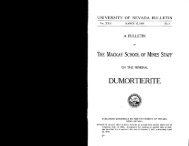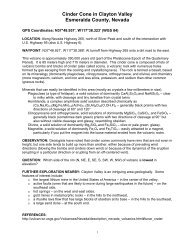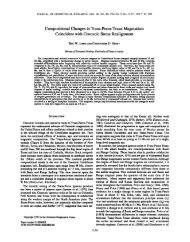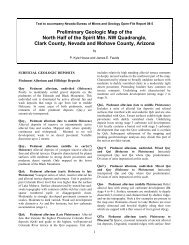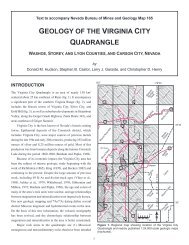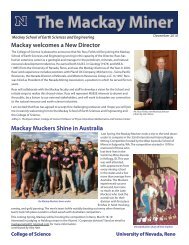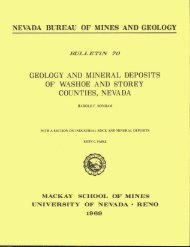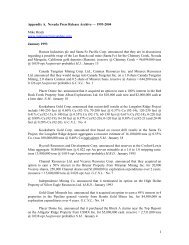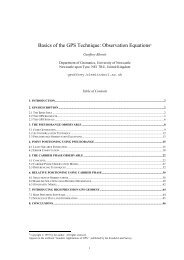Nevada Bureau of Mines and Geology - University of Nevada, Reno
Nevada Bureau of Mines and Geology - University of Nevada, Reno
Nevada Bureau of Mines and Geology - University of Nevada, Reno
You also want an ePaper? Increase the reach of your titles
YUMPU automatically turns print PDFs into web optimized ePapers that Google loves.
LOCATION<br />
DISASTER DISTRICT<br />
The Disaster district is located on the northeast <strong>and</strong> east sides <strong>of</strong><br />
the Kings River Valley in the Montana Mountains (Trout Creek Mountains <strong>of</strong><br />
Willden, but incorrectly named). The district starts, or ends, at the<br />
<strong>Nevada</strong>-Oregon border <strong>and</strong> runs south down the range front for 10 to 15<br />
miles. For the purposes <strong>of</strong> this report however, it's going to include all<br />
the area on the east side <strong>of</strong> the Montana Mountains south to the Thacker<br />
Pass road. All the mines <strong>and</strong> prospects can be located on the Disaster Peak<br />
<strong>and</strong> Thacker Pass 15 minute topographic maps.<br />
HISTORY<br />
Very little information is available in the way <strong>of</strong> recorded history<br />
on this district. It is known that small amounts <strong>of</strong> gold, silver, mercury,<br />
<strong>and</strong> uranium have been produced. Most <strong>of</strong> the mineralization is in the form<br />
<strong>of</strong> lode occurrences but there are also two placer gold occurrences.<br />
V<strong>and</strong>erburg reports that work on the placer deposits was being done in the<br />
district as early as the late 1870's. Historically the area has received<br />
very little attention from explorationists until the mid to late 1970's<br />
when uranium was an attractive commodity to look for. During this time<br />
period the entire area, as far east as McDermitt <strong>and</strong> south to State Route<br />
140, was staked, <strong>and</strong> explored for uranium. Several areas within the<br />
district have drill indicated reserves <strong>of</strong> uranium as a result <strong>of</strong> this<br />
work. However, individual deposits are small <strong>and</strong> low-grade, being on the<br />
order <strong>of</strong> 5 lb per ton U 0 Current activity is restricted to gold<br />
exploration by Placer ~$d?*in the Ikes Canyon area <strong>and</strong> to lithium <strong>and</strong> clay<br />
exploration by Huber Corp. in the Big Bend Spring area. It is not known<br />
what the total production has been from the district. It is known that<br />
about 500 tons <strong>of</strong> uranium ore has been produced; that a few ounces <strong>of</strong> gold<br />
<strong>and</strong> silver have been produced; <strong>and</strong> that a very few flasks <strong>of</strong> mercury may<br />
have been produced.<br />
GEOLOGIC SETTING<br />
Most <strong>of</strong> the range is underlain by rhyolitic to dacitic flows <strong>and</strong><br />
welded tuffs, but large areas <strong>of</strong> granodiorite <strong>and</strong> related intrusive rocks<br />
occur in the northwestern part <strong>of</strong> the range. The intrusive rocks are<br />
overlain by coarsely porphyritic basalt <strong>and</strong> unmapped thin sedimentary<br />
units near the border <strong>and</strong> extending into Oregon. The intrusive rocks are<br />
mainly granodiorite but their composition varies considerably, mostly in<br />
the amount <strong>of</strong> included dark minerals. Alaskite is locally intrusive into<br />
the granodiorite near Flat Creek. Flow units are exposed on the north side<br />
<strong>of</strong> Thacker Pass, <strong>and</strong> the zone <strong>of</strong> flow units persists for a considerable<br />
distance to the north, at least as far as Horse Creek.<br />
The important structural features are some persistent normal faults<br />
along the west front <strong>and</strong> in the northwestern part <strong>of</strong> the range. These<br />
faults <strong>of</strong>fset all the rocks <strong>of</strong> the range. The oldest is considered to be<br />
the Moonlight fault. This is an east-dipping normal fault that has a<br />
Disaster District - 1



